circut breaker trips everytime I turn off lights
I tried to install two recessed lights in series in a 57 year old house. The new fixtures don't use wire nuts they come with a plug type connection. I used the existing wiring to the first fixture and new wiring between the first and second fixture then the existing wiring from the second fixture. I hooked up the hot to hot and neutral to neutral. The new fixtures and new wire, have a ground however there is no ground in the original wiring. I have connnected the ground in the new wiring to that of the fixtures.
When i turn the light switch to the on position and then turn on the circuit breaker the lights come on. When I turn off the lights it trips the circuit breaker. I tried to check the connections, and while the light switch was in the off positon, I then tried to flip the breaker and it trips immediately.
I thought the polarity may be reversed so i plugged in the existing netural into the new hot connection and the existing hot into the new neutal connection. but the same results.
Please help with any advise.
Comentarios (24)
joed
hace 14 añosYou have miswired a switch loop. There was probably a white and black connected together that you thought you should correct because the colours didn't match. You are actually turning on the light switch when the breaker trips.
js981113
Autor originalhace 14 añosto tell you the truth, when i took the old fixture off i didn't look to see how it was wired, i just assumed it was wired the conventional way. i'll look to see if they wired a white and black togeather.
I have not dug into the switch yet. I believe it is in-fact a single pole. I don't know of another switch. I'll look to be sure.
Ive been thinking, the existing cable went from the switch to the fixture, then the existing cable continued from the switch to something else. So there must be something else controlled by the switch. either way it looks like i'm going to have to find where the cable goes.
js981113
Autor originalhace 14 añosI have diagrams i would like to post. joed, could you let me know how you posted the diagram from MS paint.
joed
hace 14 añosYou need to host the drawing some place like photobucket.
then use the following code replacing () with . It is standard HTML coding.(img src="insert direct link to image"/img)
js981113
Autor originalhace 14 añosBelow is my existing wiring diagram
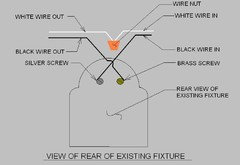
Below is my proposed wiring diagram
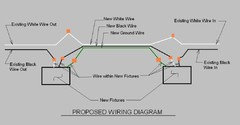
Last night i followed my proposed wiring diagram and it worked...kind of. As expected for one light to work both fixtures needed a light bulb, but what really got my attention was the intensity of the bulbs.
When I plugged in one regular 75W light bulb and a compact florecent bulb (CFL), the CFL was bright and seemed normal, however the 75W bulb barely lit up. I then switched bulbs in the lights fixtures and the same result, thus ruling out a bad fixture.
I then tried two 75W bulbs and they lit up, however they were much dimmer than I expected. Why would this be the case? I know the CFL, although rated as a 100W acutally uses 35W or 45W. So with that said, is the wattage to the fixtures low. Which would lead me to think the old wiring has a low current carring capacity, is this also correct? and if so what can i do about it, other than replacing all the wires?
brickeyee
hace 14 añosYou have wired the two fixtures in series.
They need to be in parallel from the switched hot to neutral.Billl
hace 14 añosYep - you are running the power through a resistor ie the light and then on to power another resistor ie the second light. That is where the drop is occurring and why the bulbs dim.
Basically, you need live and neutral coming in. The live needs to go down to the switch loop and then return. The return should be marked black. Then, the live should go to both the black wires for the lights, not through one light and onto the next. The whites from both lights should be connected to the neutral in.
This thread has a sample diagram with 3 lights on a switch loop.
Here is a link that might be useful: parallel
joed
hace 14 añosThe fixtures are series wired. You need to connect the black wires together and to the gold screw.
Connect the white together and to the silver screw.js981113
Autor originalhace 14 añosOk. I've looked at joed's last post and have come up witha new wiring diagram of which i have tried to show is parallel.
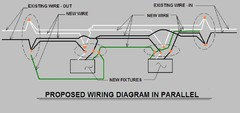
What do i do with the ground wire in the new cable, when trying to connect to the existing wire going out?
samneric
hace 14 añosWhat do i do with the ground wire in the new cable, when trying to connect to the existing wire going out?
Unless your old existing cable has a grounded metallic sheath terminating into metal boxes, do NOT connect the "ground wires" in the new cable to ANYTHING - including each other. Cap them off individually at both ends.
Attaching ungrounded "ground" wires between fixtures only ensures that a ground fault on one fixture will also make the other fixture hot.
Based on your wild misunderstanding of the "conventional" way to wire light fixtures, I'm thinking that you really need to buy and study a basic wiring book or hire a local licensed electrician.
hendricus
hace 14 añosI almost wrote this up last night.
If in wires are from main panel and out wires are to switch, then
In white to both lights
in black to out white, remark white to black
Out black to both lights
cap all grounds
fasten to switch out white remarked black and out black
if the first statement is not true then disregard all this
The main problem you have here is two blacks going to a light fixture. Each fixture needs a black and a white in order to operate properly.
joefixit2
hace 14 años"Based on your wild misunderstanding of the "conventional" way to wire light fixtures, I'm thinking that you really need to buy and study a basic wiring book or hire a local licensed electrician."
I have to agree. I know this is a DIY site, but when it comes to something like electricity the DIY should at least take the time to gain some knowledge on theory and circuits, and learn some basics before diving in. Getting it to work by trial and error is not a good idea at all, and with no knowledge of what you are doing can be a dangerous thing. Sure eventually you can get it to work, but how safe will it be? Have you considered the fact that the circuit breaker is possibly damaged from the repeated short circuiting and should be replaced?
linesman
hace 14 añosHello js981113
The lights should be wired in parallel. Here is your diagram, that I
revised on how to re-wire your lights.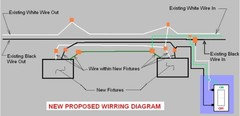
Hope this helpsÂ
let us know how you made out with your project!!Have A Nice Day
Linesmanterribletom
hace 14 añosYep, Linesman's diagram makes for a righteous fix.
That is, it'll work depending on where the switch is. I've been lurking on this thread and never have been able to figure out where the switch loop is located.
(I feel your pain on that, Hendricus! I started a similar reply last night and then deep-sixed it because of that uncertainty.)
So...if the switch loop is somewhere other than where Linesman has put it, then stop back in for further alterations.
Gotta agree with a couple of the others, too. Without understanding how the circuitry works, this trial-and-error approach is a tad scary to say the least.
Woody Woodford
hace 3 años
I have exactly the same problem as the original poster. I am also a lot less knowledgable and don’t have the black and white wires referred to in the probable solution. Any plain English suggestions welcome. 🤞🏻Usuario de Houzz-719434043
hace 2 añosAssuming one set of wires are power and the other set are the switch. The two red wires should be joined together and only to each other. One black wire should be joined to the blue second live wire and one black wire should be joined to the brown first live wire. The black wire that connects to the brown first live wire should be identified with a wrapper of red insulation tape to show that it is indeed the live switch feed.
Grinders Contracting
hace 2 añosLight comes on in kitchen and laundry room but when i hit the switch it trips the breaker.
Usuario de Houzz-143678890
el último mesSame issue here, only my breaker box is 25' from the door of my crawlspace and I got tired of going under there and quit for today. Just left the light on while the switch says off. I am sure I wired the new light the same as the old one was wired. It's the end of a 3 fixture string. There are 2 black, a white, a grey, and a ground. The 2 blacks were with the black on the fixture. The white and grey were with the white of the fixture. The ground to the ground. I mean, that's simple, right? How could I have messed that up? Now the switch is in the off position and the light is on. Turn it off and trip the breaker. Keep the switch at off and reset the breaker and it trips immediately. I plan to undo and redo it tomorrow, but I don't fathom any new result. Any thoughts and/or advice? I am not a professional but I do reviews for Kichler so I've installed and/or replaced more ceiling fixtures than I can count and thus has never happened before. Thanks- Karen

Volver a cargar la página para no volver a ver este anuncio en concreto
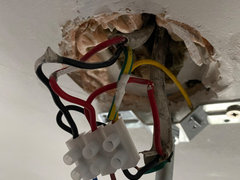
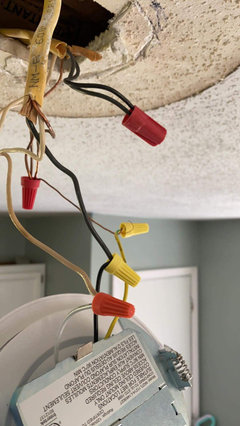
Ron Natalie